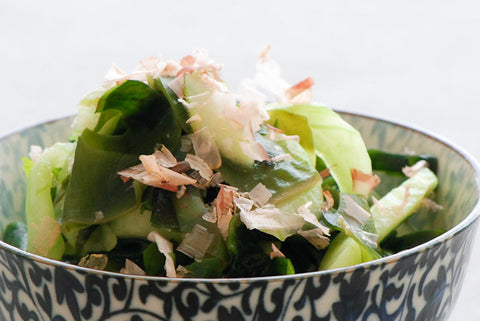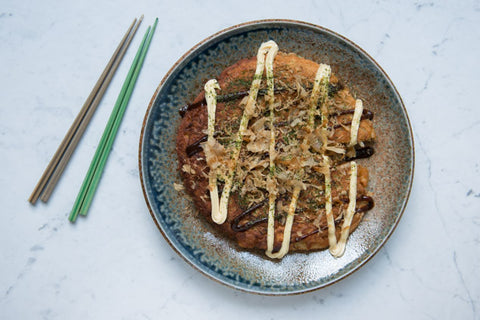What Are The Benefits Of Seaweed And How Can You Use It In Your Cooking?
by Nicola Lando

Seaweed is a delicious ingredient to introduce to your kitchen. It’s very versatile and can be bought in nori sheets, sprinkles, sea spaghetti or dashi form to enhance your dishes and offer a unique taste.
Take a look at the top health benefits of seaweed and the ways you can use it in your cooking to wow your guests and introduce a new food to your dinner table.
What Are The Amazing Health Benefits Of Seaweed?
Seaweed has many health benefits that have been enjoyed in Japan for thousands of years. In fact it’s hit the headlines as part of the ‘Okinawa Diet’ - where the population ate seaweed daily, and - until 2000 - had one of the longest life expectancies in the world. Here’s why seaweed is considered a health food...
It’s A Good Source Of Vitamins and Minerals
Seaweed is renowned as a superfood as it’s full of vitamins and minerals that help to support the immune system and protect the body. It’s full of minerals such as Riboflavin, Iron and Copper, as well as vitamins A, C, E and K.
It Contains Powerful Antioxidants
Antioxidants are brilliant at protecting the body against free radicals that can damage your cells. Free radicals are thought to enhance the risk of disease and damage the body.
It Supports Weight Loss
A Newcastle University study found that seaweed can reduce the rate of fat absorption into the body by up to 75 percent. Therefore, seaweed could have amazing benefits when it comes to inhibiting the effect of the enzyme lipase and helping people keep weight off.
What Different Textures Of Seaweed Are There?
There are a variety of different types of seaweed for both aesthetics and texture. Sea Spaghetti and Irish Moss are great as a crunchy addition to a dish, as they hold a strong shellfish flavour and have a crunchier texture.
Alternatively, Nori and Sea Lettuce are great for a more delicate texture and softer mineral flavour. These smoother varieties of seaweed appear more often in Western Cuisine as they have a more spinach-like flavour and smooth texture that emulates the kind of food that appears in the Western diet.
How To Cook With Dried Seaweed
Dried seaweed comes in three different forms:
Seaweed to eat after soaking in water
Seaweed dries extremely well, and when rehydrated these dried seaweeds are very similar to eating fresh seaweed. A very easy place to start is with a simple Japanese wakame salad, or even blend together a number of different seaweeds to make a seaweed tapenade recipe to serve with pasta instead of pesto.
Spaghetti served with a quick seaweed tapenade
Just rehydrate the seaweed according to instructions on pack, and you’re ready to be creative!
Dried seaweed for cooking stocks
Seaweed is a fantastic source of natural monosodium glutamate (MSG) - natural umami, or the fifth taste. That is usually described as a rich savoury flavour, otherwise found in tomatoes and mushrooms.
And Japanese kombu seaweed is particularly high in naturally forming MSG. Because of this, kombu it is a key ingredient in Japanese soup stocks. However, the sheets can be fairly thick and tough, so you wouldn’t really want to eat it - even after simmering for some time.
Dried seaweed to eat from the packet
Nori seaweed you could eat straight from the pack, and is sold ready to be rolled around sushi. It’s mellow tasting, soft and delicate as it gets its flavour and structure from the sushi inside.
Crispy seaweed is made from fried sheets of nori seaweed and is also a great snack on its own, or can be used to garnish noodle dishes and ramen. The crispy seaweed sheets are heavily seasoned to make them great alternatives to crisps. You can even buy Kimchi-flavoured crispy seaweed.
How To Use Seaweed In Sushi Making
Sushi refers to the short-grain rice that’s cooked and seasoned with sushi vinegar to give it a full flavour and sticky texture.
Nori Seaweed has been used as a traditional sushi making technique in Japan since the 8th century, and still remains one of the most common ways to use seaweed. Flat pressed sheets of nori seaweed - are ideal for this purpose. All you need are some Nori Sheets, a bamboo rolling mat and some japanese sushi rice.
Styles of sushi can vary. However, the most popular varieties that use seaweed are maki, temaki, and uramaki. The easiest sushi to make with seaweed is maki, as they can be rolled in one wrap-style piece of seaweed that can then be cut into small bite-sized pieces. If you’re just starting out with sushi making, maki is a great place to start.
Our simple sushi making kit is the perfect way to get started, and with our handy blog on how to make maki rolls, you should be able to learn how to use Nori seaweed in no time. Plus, if you’re a sushi beginner but want to learn more, then Hashi: A Japanese Cookery Course by Reiko Hashimoto is a great read.
How To Use Seaweed Flakes
Using Aonori Seaweed Flakes in your cooking is a great way to garnish Japanese dishes. The fragrant and fresh green seaweed comes from the same family as the sea lettuce and harbours a strong, mineral-rich flavour.
If you want to use the seaweed flakes in your cooking, a great way to include the ingredient is just to sprinkle them over when cooking takoyaki octopus balls, okonomiyaki pancakes, and yakisoba noodles.
Japanese okonomiyaki topped with aonori seaweed
If this article has got you excited about cooking with seaweed, then why not take a look at the variety of seaweed we have on offer. Alternatively, if you’re looking for a Seaweed Tapenade recipe to inspire you, take a look at our recipes page.

About the author
Nicola is co-founder and CEO at Sous Chef. She has worked in food for over ten years.
Nicola first explored cooking as a career when training at Leiths, before spending the next decade in Finance. However... after a stage as a chef at a London Michelin-starred restaurant, Nicola saw the incredible ingredients available only to chefs. And wanted access to them herself. So Sous Chef was born.
Today, Nicola is ingredients buyer and a recipe writer at Sous Chef. She frequently travels internationally to food fairs, and to meet producers. Her cookbook library is vast, and her knowledge of the storecupboard is unrivalled. She tastes thousands of ingredients every year, to select only the best to stock at Sous Chef.
Nicola shares her knowledge of ingredients and writes recipes to showcase those products. Learning from Sous Chef's suppliers and her travels, Nicola writes many of the recipes on the Sous Chef website. Nicola's recipes are big on flavour, where the ingredients truly shine (although that's from someone who cooks for hours each day - so they're rarely tray-bakes!).








